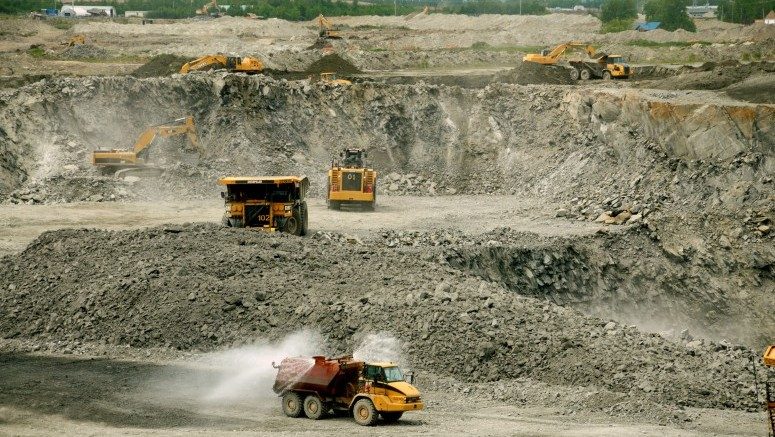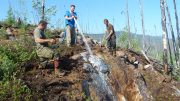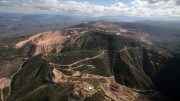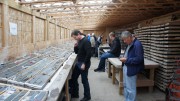Shares of Abitibi Royalties (TSXV: RZZ) are up 168% since April 2016 — surpassing the Philadelphia Gold & Silver Index, which in Canadian dollars was up 90% in 2016.
The company’s shares traded at a 52-week low in April last year of $3.45, and touched a 52-week high of $10.75 in February 2017. They trade at $9.24 apiece.
The junior recently released exploration results from the Odyssey gold deposit, which is 1.5 km east of the current limit of the Canadian Malartic open-pit gold mine in Malartic, Que., midway between Rouyn-Noranda and Val-d’Or.
Abitibi holds a 3% net smelter return royalty (NSR) on the Odyssey North zone within the Canadian Malartic mine property, which has been jointly owned by Agnico Eagle Mines (TSX: AEM; NYSE: AEM) and Yamana Gold (TSX: YRI; NYSE: AUY) since 2014.
“The clear outperformance of our stock was due to Odyssey,” Abitibi Royalties president and CEO Ian Ball says in a telephone interview.
He notes that Agnico Eagle and Yamana started off with a $3-million exploration budget at Odyssey for a 25,000-metre drill program in 2015, and drilled 119,400 metres in 155 holes in 2016.
The Odyssey property is made up of the Odyssey North and Odyssey South zones, which strike east to southeast and dip steeply south. Odyssey North has been traced from 600 metres to 1,300 metres below surface along a 1.5 km strike length, while Odyssey South has a strike length of 0.5 km and has been located between 200 and 550 metres below surface.
In February, Agnico and Yamana completed an initial inferred resource on the two Odyssey zones of 20.7 million tonnes grading 2.15 grams gold per tonne for 1.43 million oz. gold.
The companies also announced that they had found a zone at the Odyssey deposit called the Internal zone, which was not included in the resource estimate, but returned promising intersections, including 3.10 grams gold over 91.5 metres, 4.24 grams gold over 12.5 metres and 3.23 grams gold over 10.5 metres.
“There are certain parts of the Odyssey deposit our royalty does not cover, but it covers the majority of it,” Ball says, adding that “they’re continuing to make discoveries … and it seems like Odyssey could become a larger deposit.”
Ball notes that Abitibi’s royalty on Odyssey covers 1.04 million of the 1.43 million oz. inferred resource, and hopes that the Internal zone can add to those numbers.
“We don’t know how this is going to impact us until they come out with a new resource,” he says. “The Internal zone is right in the middle of the Odyssey deposit. It’s a cross-structure going north–south versus the main deposit, which runs east–west.”
In addition to the 3% NSR on Odyssey North, Abitibi holds NSRs on other near-pit zones that were previously outlined by the mine operators, which include the eastern part of the Gouldie zone (2% NSR); Charlie zone (2% NSR), the eastern part of the Barnat extension-Barnat South Wall contact (3% NSR); and the Sheehan zone (3% NSR).
Ball, who joined Abitibi in 2014, says another factor in the company’s successs is its business philosophy.

A gold pour at Agnico Eagle Mines and Yamana Gold’s Canadian Malartic gold mine in Quebec. Abitibi Royalties holds a 2% net smelter return royalty on the Gouldie deposit and Charlie zone at Canadian Malartic. Credit: Osisko Mining.
“One of the things we have told our shareholders is that only under rare conditions would you ever see us issue shares,” he says. “When I joined in 2014 we had no money, so we did do a financing with Rob McEwen, but since that time we haven’t done any financings or issued any new shares for acquisitions. It’s been the exact opposite — we’ve been buying back shares.”
Since 2015, Abitibi has spent $630,000 repurchasing 120,000 of its own shares at an average $5.25 per share, and management’s goal is to get the share count down from the current 11.2 million to 10 million, Ball says.
“We don’t have a firm date on that. We’ll be opportunistic when we repurchase the shares,” he says, adding “there aren’t too many juniors who have a $100-million market cap at a $9 share price.”
He adds that “the whole idea has been to keep the business model simple. That’s how we’ve gone about things differently. There are going to be no new share issues. We will continue to do buybacks, and we have our cash flow coming from our investment portfolio in addition to royalties, which will add to our cash flow starting next year, and on top of that, you have the exciting growth coming from Odyssey.”
Abitibi owns 3.5 million shares in Yamana and 335,000 shares in Agnico Eagle, holds $8 million in cash and has no debt.
Since setting up its Royalty Search portal — an online platform that junior mining companies and prospectors can use to pitch their properties to Abitibi — the company has acquired 18 royalties at a cost of $195,000.
In the last two months alone, Abitibi has bought four new royalties through its web portal.
Two of them, unveiled in February, are near existing mines in Ontario and Manitoba. The first agreement, in partnership with AuRico Metals (TSX: AMI), gives each company a 0.75% NSR on nine exploration properties throughout the Rainy River district in Ontario, near New Gold’s (TSX: NGD; NYSE: NGD) Rainy River gold mine under construction, 65 km northwest of Fort Frances.
“In the Rainy River royalties and that district you don’t see a lot of active companies because New Gold and Rubicon have most of the land, and neither of them are focused on district opportunities,” Ball says.
“There was limited prospecting on those claims, and there were positive signs of higher grades in some of the rock samples taken historically, so we said, ‘OK, there’s been little exploration and New Gold’s Rainy River mine is going through teething problems,’ and that’s when you probably want to acquire claims, when no one else is in the area.”
The second NSR Abitibi picked up is another 1% royalty on privately held Nordic Minerals’s exploration property, 5 km southwest of Hudbay Minerals’ (TSX: HBM; NYSE: HBM) 777 polymetallic mine in Manitoba. The royalty near the 777 mine was one of the first royalties Abitibi ever acquired (a 2% NSR), and the latest acquisition brings its total royalty interest on the property to 3%.
“It appeared, based on historic documents, that Hudbay had drilled close to the property and hit mineralization similar to their 777 mine,” Ball says. “It’s hard to know whether the thicknesses is economic, but there was mineralization of a reasonable quality, and we liked what we saw when we looked at the drill assays.”
Ball adds that Nordic Minerals — an exploration company that is involved in oil and gas, as well as minerals — is expected to raise flow-through financing this year to fund exploration at the property.
In March, Abitibi acquired a new royalty next to Goldcorp’s (TSX: G; NYSE: GG) Red Lake gold mine in partnership with AuRico Metals. Under the agreement, each company has acquired a 1% NSR on two exploration properties, 6 km east and 8 km south of the Red Lake mine.
One set of claims is attached to the historic Madsen gold mine. “When you look at where the claims are and you look at where the historic underground workings from Madsen are located, our royalty is not far from the property boundary,” Ball says. “It seemed to us that there was the possibility that Pure Gold, which owns the Madsen mine, would drill ever closer to the property boundary, which seems to be the case. That was one of the biggest producers of gold in Red Lake.”
The other royalty, closer to the Red Lake mine, Ball says, was acquired because there is a geological fold east of the Red Lake mine and the claims are just off the fold. “From a geological perspective, it is pretty prospective,” he says, adding that Abitibi wants to capitalize on what it knows: North America and precious metals.
“We want to stay 80% in North America and 80% in precious metals,” he says. “We are not going to venture into new areas where we have no expertise or commodities where we have no skill set — that’s probably a quick way to lose money.”
Large shareholders in the company are Golden Valley Mines, which holds a 49.9% stake, and Rob McEwen, who has a 12.3% interest.






Be the first to comment on "Abitibi Royalties is on a roll"